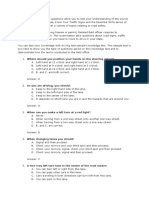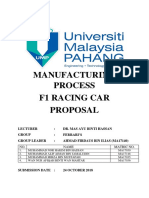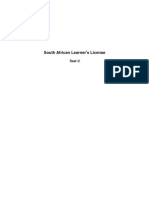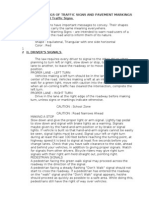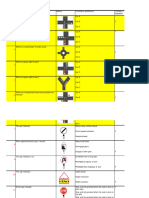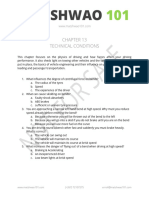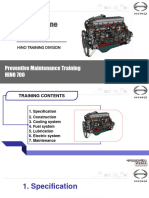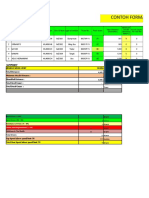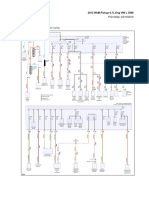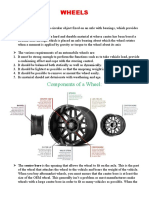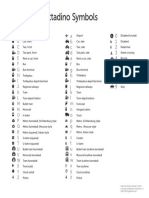Paper 4 Revision
Paper 4 Revision
Uploaded by
k.kgabukiCopyright:
Available Formats
Paper 4 Revision
Paper 4 Revision
Uploaded by
k.kgabukiCopyright
Available Formats
Share this document
Did you find this document useful?
Is this content inappropriate?
Copyright:
Available Formats
Paper 4 Revision
Paper 4 Revision
Uploaded by
k.kgabukiCopyright:
Available Formats
MATSHWAO 101
REVISION PACK
1. You have a reaction time of 1 second. Which stopping distance must you anticipate by
the rule of thumb if you are travelling at 50 km/h?
a. 15 metres
b. 40 metres
c. 5 metres
2. What makes driving in a stream of vehicles easier?
a. Driving in a slightly staggered position in your own lane & watching the queue
through the windows of the vehicles travelling in front
b. You only drive in gear one
c. Driving with at least 1km distance to the vehicle in front
3. You are the first person to arrive at the scene of an accident with injured persons. In
which order do you proceed?
a. Call the rescue service only an leave the accident scene
b. Make the scene of the accident safe, give first aid, call the rescue service and the
police
c. Ask other road users to take necessary action
4. What is entered in the demerit point system (Central Card Index Server)?
a. The central index stores only criminal offences
b. The demerit point system records only licensed vehicles
c. Traffic offences, points and fines for all road users
5. Where is parking prohibited?
a. In residential areas
b. On special designated car parks near shopping centers
c. On narrow roadways opposite driveway entrances and exits
6. Up to which permissible total mass may light vehicles be parked on specially designated
footpaths?
a. 16 t
b. 7.5 t
c. 3.5 t
7. Before which signs are you not allowed to stop within a distance of 10 m if the signs
would be concealed by your vehicle?
a. Railway cross, Stop! and Give Way
b. Cul desac
c. Police Station
Matshwao 101 www.matshwao101.com (+267) 72107275
8. What is the minimum distance a vehicle must leave clear in front of traffic lights if the
traffic lights would be concealed by the vehicle?
a. ((10)) m
b. ((5)) m
c. Exactly 2 metres
9. What influences the degree of centrifugal force on bends?
a. The radius of the bend and speed
b. The ability of the driver
c. When driving a new vehicle
10. You drive round a bend once at 30 km/h and again at 60 km/h. How the centrifugal
forces change?
a. Centrifugal force at 60 km/h is three times as high
b. Centrifugal force at 60 km/h is two times as high
c. Centrifugal force at 60 km/h is four times as high
11. When are you not allowed to use a motor vehicle on public roads?
a. When the vehicle is older than 10 years
b. When it is not roadworthy
c. When it is raining
12. What must you take into consideration when checking tyre pressure?
a. Tyre temperature
b. Car temperature
c. Tyre age
d. Tyre pressure depends on who is driving
13. In which cases is it imperative to test the brakes?
a. When your vehicle has not moved for a long time
b. Each time you leave a mall
c. Brakes must be checked on a daily basis
14. Whilst braking, you notice that your car pulls to the right hand side. What can be the
reason?
a. The road has been built that way, means it forces drivers to keep the far left
hand side
b. The brakes need to be oiled immediately
c. The road surface affords more grip on the right hand side than on the left hand
side
15. You are involved in a traffic accident. What are you required to do?
a. You may leave the scene and inform your insurance within 48 hrs
b. You must inform the police that you were involved in an accident
c. You must inform the licensing authority that you were involved in an accident
16. Why are you required to have a defective exhaust system repaired immediately?
a. Because of the increased noise pollution
b. Because you may be fined by the police
c. Because of the decreased emission pollution
Matshwao 101 www.matshwao101.com (+267) 72107275
17. What must you remember if you want to carry luggage on the roof of your car?
a. The maximum roof load stipulated by the licensing authority must not be
exceeded
b. The permissible unladen weight of the vehicle must not be exceeded
c. The maximum roof load stipulated by the car manufacture (owner’s manual)
must not be exceeded
18. What must you check when transporting bicycles on rear-mounted support system?
a. Whether, according to the manufacture’s indications, the system is adequate for
the vehicle
b. Transporting bicycles is illegal
c. Rear mounting support is only available when driving a truck
19. What should be remembered with the regard to the load of a vehicle?
a. The permissible total mass and permissible axle weights must not be exceeded
b. The permissible empty mass must not be exceeded
c. All vehicles may have only two axles for distribution of the load
20. You are holding a driver’s license class B. Your vehicle has the following specifications:
Empty (unladen) weight 900 kg – total mass GVM 1 400 kg. Which trailer are you
allowed to tow?
a. A trailer with GVM of 850 kg for which I do not need class EB
b. A trailer with GVM of 850 kg for which I need class EC1
c. A trailer with GVM of 850 kg for which I need class EB
21. When must you wear safety belts?
a. When driving in built up areas
b. Only at night
c. When reversing for parking
22. When is it not necessary to wear safety belts?
a. When driving at walking speed, i.e. parking
b. When reversing for parking
c. When driving in built up areas
23. At which impact speed must you reckon with serious or deadly injuries when no safety
belt is worn?
a. From 30 km/h onward
b. From 60 km/h onward
c. When reversing at high speed
24. How is fuel wasted and the environment polluted?
a. By ‘playing with the accelerator” while waiting at traffic lights
b. By changing to a higher gear as early as possible
c. By driving without lights at nights
Matshwao 101 www.matshwao101.com (+267) 72107275
25. What must you do after an accident with a game animal?
a. Wait till another driver arrives to clean the accident scene
b. Stop and take the game animal in your car for own consumption
c. Stop, switch on hazard warning light and make the scene of the accident safe
26. The fuel consumption of your vehicle is higher at peak traffic periods in urban traffic
than at other times. Why?
a. Because you have to brake and accelerate more often
b. Because you have to use windscreen wipers more often
c. Because you have to park your car more often
27. What can help save fuel and reduce pollution?
a. Using public transport, a bicycle or walking, wherever possible
b. Driving at speeds not more than 20 km/h at all times
c. Driving at night only
28. A faster car overtakes you on a country road and into your lane. How do you react?
a. You control your annoyance, remain cool and proceed as if you had not noticed
this.
b. Increase your speed and shout at the driver
c. Increase your speed to avoid a dangerous situation
29. What is the maximum permissible height of a vehicle including load?
a. 6 meters
b. 3.5 meters
c. 4.3 meters
30. You want to transport holiday luggage, i.e. a boat on the roof of your vehicle. What must
you remember?
a. I may transport such luggage only for the next 10 km
b. Not to exceed the permissible total mass (GVM) of the car
c. Transporting holiday equipment is not permitted by law
Matshwao 101 www.matshwao101.com (+267) 72107275
You might also like
- Zimbabwe Provisional Theory1Document16 pagesZimbabwe Provisional Theory1cloppschimedza100% (1)
- Matshwao 10Document9 pagesMatshwao 10Omphile DansonNo ratings yet
- Pass On First Attempt k53 Learner's Road Signs Study GuideDocument44 pagesPass On First Attempt k53 Learner's Road Signs Study Guidenombusomhlanga752No ratings yet
- Test No.: 012 008 B2 StencilDocument2 pagesTest No.: 012 008 B2 StencilCalvawell Muzvondiwa100% (12)
- Oral Driving School Lessons 2022Document6 pagesOral Driving School Lessons 2022Dean DambazaNo ratings yet
- Direct Drive Engine Overhaul Manual 60294-7-13Document151 pagesDirect Drive Engine Overhaul Manual 60294-7-13Filipe Rosa100% (2)
- Botswana Road Traffic Signs 1 PDFDocument3 pagesBotswana Road Traffic Signs 1 PDFRodney Pheto67% (3)
- Driving Test Sample Test QuestionDocument29 pagesDriving Test Sample Test QuestionZubeer Ahamed100% (2)
- Road Theory Test 7Document6 pagesRoad Theory Test 7Christina NgwakoNo ratings yet
- 美国伊利诺伊州2010版驾照考试笔试 (permit) 题库Document11 pages美国伊利诺伊州2010版驾照考试笔试 (permit) 题库chensac33No ratings yet
- Learners Licence TestDocument20 pagesLearners Licence TestMinenhle Ma-India KaShengeNo ratings yet
- Gakka Eng141209 PDFDocument22 pagesGakka Eng141209 PDFkirankumarmrNo ratings yet
- Field DrivingDocument10 pagesField DrivingTalent Muparuri100% (2)
- Driving Written TestDocument3 pagesDriving Written Testanand3162No ratings yet
- 2009 Ford Mustang Brochure From Miller FordDocument22 pages2009 Ford Mustang Brochure From Miller FordMiller Ford100% (3)
- Uganda Gravel Roads Design, Vol.3Document30 pagesUganda Gravel Roads Design, Vol.3Michael Kazi100% (10)
- F1 Car Project ProposalDocument4 pagesF1 Car Project ProposalFirdaus IliasNo ratings yet
- Powertrain Control Module (PCM) : Pin No. Description Connected ToDocument24 pagesPowertrain Control Module (PCM) : Pin No. Description Connected ToEd KlbNo ratings yet
- Godfrey BW Theory Revision Chapter 4Document8 pagesGodfrey BW Theory Revision Chapter 4Tanaka ChizNo ratings yet
- Chapter 10 Q&A Parked VehiclesDocument8 pagesChapter 10 Q&A Parked VehiclesTanaka ChizNo ratings yet
- Road Theory Test 6Document7 pagesRoad Theory Test 6Christina NgwakoNo ratings yet
- Pass On First Attempt k53 Learner's Rules NombusoDocument31 pagesPass On First Attempt k53 Learner's Rules Nombusonombusomhlanga752No ratings yet
- Road Theory Test 2Document6 pagesRoad Theory Test 2Christina NgwakoNo ratings yet
- Model Test Questions and Answers For Learner'S Licence Preliminary TestDocument22 pagesModel Test Questions and Answers For Learner'S Licence Preliminary TestrvrbangNo ratings yet
- Driving Test 2Document4 pagesDriving Test 2Kumbirai KaruwoNo ratings yet
- Class 7 TestDocument21 pagesClass 7 TestTuhi HashimNo ratings yet
- Test 4 StencilDocument2 pagesTest 4 StencilLarona Sivako100% (1)
- Final Test Number 5Document2 pagesFinal Test Number 5tlotlo mmualefeNo ratings yet
- Matshwao 8Document10 pagesMatshwao 8Omphile DansonNo ratings yet
- Test 3 StencilDocument2 pagesTest 3 StencilLarona SivakoNo ratings yet
- Final Test 7-ReviewDocument2 pagesFinal Test 7-ReviewLarona SivakoNo ratings yet
- Test 1 Stencil-1Document2 pagesTest 1 Stencil-1Larona SivakoNo ratings yet
- Paper 9A: / Year / YearDocument2 pagesPaper 9A: / Year / YearMartin Khumalo100% (2)
- Lto HighlightDocument10 pagesLto HighlightRalph Louie ManagoNo ratings yet
- Test CDocument16 pagesTest CatlegangmakulaNo ratings yet
- At Marked Stop Line, Before Entering The Crosswalk, or Before Entering The Intersection If There Is No CrosswalkDocument5 pagesAt Marked Stop Line, Before Entering The Crosswalk, or Before Entering The Intersection If There Is No CrosswalkMrudul PatilNo ratings yet
- Defensive Driving Quiz Multiple ChoiceDocument4 pagesDefensive Driving Quiz Multiple ChoiceAj100% (1)
- Oral Lessons Notes NurianDocument5 pagesOral Lessons Notes NurianNosipho NcubeNo ratings yet
- Imsor Book BDocument24 pagesImsor Book Bgevann.mullinsNo ratings yet
- Test ADocument16 pagesTest AatlegangmakulaNo ratings yet
- k53 MasterDocument20 pagesk53 MasterwarnervanhoyNo ratings yet
- Types and Meanings of Traffic Signs and Pavement Markings 1 I. International Traffic SignsDocument12 pagesTypes and Meanings of Traffic Signs and Pavement Markings 1 I. International Traffic SignsRmae LongakitNo ratings yet
- Drivers Manual Sample Test QuestionsDocument2 pagesDrivers Manual Sample Test QuestionsSheri BeamanNo ratings yet
- Microsoft Word - DMVQuestion and AnswersDocument5 pagesMicrosoft Word - DMVQuestion and AnswersHeaven ReeceNo ratings yet
- Sample Questions For Newfoundland and LabradorDocument10 pagesSample Questions For Newfoundland and LabradorLuesma Fully (STUDENT)No ratings yet
- LearnersDocument3 pagesLearnersLora KingNo ratings yet
- FREE CheatSheetDocument15 pagesFREE CheatSheetsharmilaiyerNo ratings yet
- 9358 PDFDocument14 pages9358 PDFgems2011No ratings yet
- Learners LicenceDocument2 pagesLearners LicenceN Rakesh83% (6)
- Examination PapersDocument32 pagesExamination PapersTinotenda Mazhowe100% (1)
- Traffic Rules and SignsDocument15 pagesTraffic Rules and SignsενձNo ratings yet
- Imsor Book ADocument24 pagesImsor Book Agevann.mullins100% (1)
- Traffic Signs and Signals: Easy Go Driving School KwekweDocument11 pagesTraffic Signs and Signals: Easy Go Driving School KwekweGamuchirai Michael Derera100% (1)
- Question Book 1Document24 pagesQuestion Book 1gibson.justin54No ratings yet
- Lto ExamDocument7 pagesLto ExamHarold Beltran DramayoNo ratings yet
- English TestDocument23 pagesEnglish Testಸುಹಾಸ ಎNo ratings yet
- Driving Test-PaperDocument110 pagesDriving Test-PaperAMITAVA ROY100% (3)
- Driving NotesDocument7 pagesDriving NotesTim KWaainuatNo ratings yet
- DoneDocument25 pagesDoneJay Em EmNo ratings yet
- Learner's Test ADocument8 pagesLearner's Test ALindokuhle Teddy100% (2)
- PRM 7 Engelska Juni 27Document57 pagesPRM 7 Engelska Juni 27lucasffonsecaNo ratings yet
- DrivingDocument64 pagesDrivingjamb2316No ratings yet
- PRM 6 Engelska Juni 03Document51 pagesPRM 6 Engelska Juni 03lucasffonsecaNo ratings yet
- Chapter 13 Technical ConditionsDocument11 pagesChapter 13 Technical Conditionslesikaseleke8No ratings yet
- Chapter 14 Q&A Using Motor Vehicles in An Environmentally Sensitive MannerDocument9 pagesChapter 14 Q&A Using Motor Vehicles in An Environmentally Sensitive Mannerk.kgabukiNo ratings yet
- Engine E13C OverviewDocument74 pagesEngine E13C OverviewciptosmgmNo ratings yet
- Chery A19 Service Manual enDocument20 pagesChery A19 Service Manual enrose100% (60)
- Contoh Format Pelaporan Dims: PT Imz Indonesia Gps-Dims ReportDocument4 pagesContoh Format Pelaporan Dims: PT Imz Indonesia Gps-Dims ReportGrifinNo ratings yet
- TB 971Document5 pagesTB 971rybthenry engineNo ratings yet
- R - C Mini Baja Car - Drive Train and SteeringDocument76 pagesR - C Mini Baja Car - Drive Train and SteeringLakshmipathy PNo ratings yet
- Ramps and Curb Ramps: U.S. A B T GDocument19 pagesRamps and Curb Ramps: U.S. A B T Gkhim zukami100% (1)
- 2012ram35006 7lDocument29 pages2012ram35006 7lAndre VPNo ratings yet
- Tuning Valve ClearanceDocument3 pagesTuning Valve ClearanceShimmer Crossbones100% (1)
- Engine Starting and Ground Up ProcedureDocument6 pagesEngine Starting and Ground Up ProcedureSThaneasMurNo ratings yet
- FICHA TECNICA CASE 580-SupermDocument6 pagesFICHA TECNICA CASE 580-SupermFaby NuñezNo ratings yet
- Wheels: Components of A WheelDocument13 pagesWheels: Components of A WheelRajandra VermaNo ratings yet
- Opening Remarks: High-Speed Rail Seminar in CaliforniaDocument22 pagesOpening Remarks: High-Speed Rail Seminar in CaliforniaiamcherryNo ratings yet
- 02-Kl3t, Penambahan Partial Part RR Axle DiffDocument4 pages02-Kl3t, Penambahan Partial Part RR Axle Diffriosyahputrasinaga21No ratings yet
- 60393748C (GB) Iveco PDFDocument176 pages60393748C (GB) Iveco PDFCesar ZarateNo ratings yet
- Cittadino Symbols: Made by Dmitry Goloub in 2013 Licensed: Attribuition-Noderivs 3.9Document1 pageCittadino Symbols: Made by Dmitry Goloub in 2013 Licensed: Attribuition-Noderivs 3.9WazzupWorldNo ratings yet
- Master List of Drawings PDFDocument117 pagesMaster List of Drawings PDFakashNo ratings yet
- Rating and Condition Assessment of Urban Road Based On Functional DistressDocument3 pagesRating and Condition Assessment of Urban Road Based On Functional Distressdeep khirsariyaNo ratings yet
- SECTION 5002 Front Axle 2WdDocument18 pagesSECTION 5002 Front Axle 2Wdlungu mihaiNo ratings yet
- 2013 - Magnaflow California CatalogDocument848 pages2013 - Magnaflow California CatalogMQPNo ratings yet
- Grove GMK 6300L 300 TN CraneDocument40 pagesGrove GMK 6300L 300 TN CraneGeorge PapakonstantinouNo ratings yet
- 2008 Town and Country OM 3rd R1Document531 pages2008 Town and Country OM 3rd R1skballNo ratings yet
- Granfield BranchDocument9 pagesGranfield Branchaugust1929No ratings yet
- Inventory Database - All Parts Inc (8/20/20)Document8,867 pagesInventory Database - All Parts Inc (8/20/20)All Parts Inc.100% (1)
- Subject: Wheel Alignment Specifications, Requirements and Recommendations For GM VehiclesDocument10 pagesSubject: Wheel Alignment Specifications, Requirements and Recommendations For GM VehiclesAnonymous 3aPuAai0% (1)
- TA 19 Bus Staircase DesignDocument6 pagesTA 19 Bus Staircase DesignMatt FryNo ratings yet







